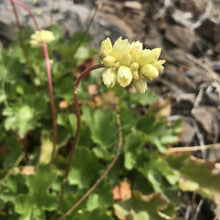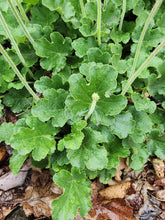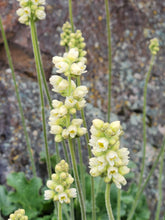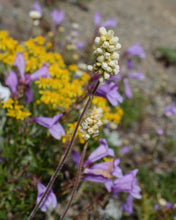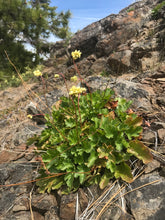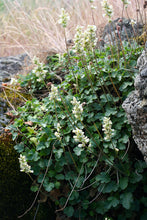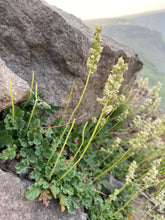
Heuchera cylindrica
Alpine alumroot, or rounded alumroot, hails from a little further east but performs marvelously in western Oregon gardens - plus it’s particularly well-adapted to the rigors of urban life. Attractive scalloped leaves form tight, low-growing mounds of year-round foliage. In late spring, striking spikes stand up to two feet tall boasting bell-shaped flowers that can be creamy yellow, light green or even pinkish. This absolutely delightful perennial hits all the highs; it's hardy, easy to grow, fast-growing, drought-tolerant AND beneficial to pollinators. Who knows when we’ll be able to offer this beauty again, so I can assure you that at least three of them are coming home to Sparrowhawk’s garden!
- Plant type/canopy layer: evergreen, perennial, herbaceous plant
- Size at maturity: 12-24” tall, equally wide
- Light requirements: full sun, part sun/part shade
- Moisture requirements: dry to moist soil, prefers well-drained
- Bloom time: April - August
- Growth rate/ease: fast growing, easy to grow
- Wildlife support: flowers attract and provide nectar for hummingbirds, adult butterflies, bees and other insect pollinators
- Native habitat/range: grows along rocky banks, cliffs and slopes, at mid to high elevations, across the Pacific Northwestern states/provinces from the Cascades eastward into parts of Nevada, Utah and Colorado. Portland Plant List - no.
- Special features & uses: evergreen; groundcover; deer resistant; drought-tolerant; highly medicinal, plethora of uses in indigenous medicine including decoctions or infusions of the roots to treat diarrhea, stomach cramps, ‘aching bones’, liver trouble, ‘changing of the blood’ - and also as an astringent or mouth rinse for sore throats, topically, it can be applied as a poultice to sores and cuts, and mixed with puffball spores as a salve for diaper rash; landscape uses include meadowscapes, pollinator gardens, rock gardens, green roofs and erosion control
Gardening with Alpine Alumroot: This is one of those unicorn species whose beauty is matched by its versatility and fortitude. This hardy perennial will find its footing quickly and persevere in pretty much any garden. Plant a drift of them spilling out of a small berm, rocky slope, or trough garden in a mostly sunny, arid location, with relatively well-drained soils and it’s sure to impress. Once established, it needs little to no supplemental water and will thrive in tough spots like parking strips (aka hell strips) and front borders. It’s generally more durable than ornamental hybrids, deer resistant and not bothered by pests or diseases.
Photo Credits 1 & 5: © Lindsey Salmonson, some rights reserved (CC-BY)
Photo Credits 2 & 3: © Jo Roberts, some rights reserved (CC-BY)
Photo Credit 4: © Alison Northup, some rights reserved (CC-BY)
Photo Credit 6: Karli Del Biondo, Beetles and Bees
Photo Credit 7: © Matt Berger, some rights reserved (CC-BY)







